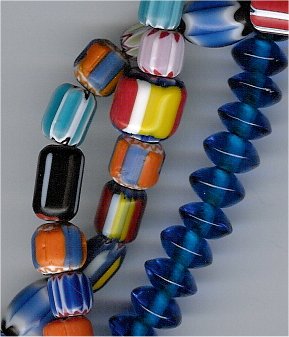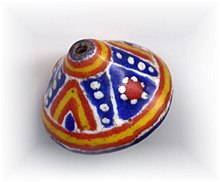
Beadwork is the art or craft of attaching beads to one another by stringing them onto a thread or thin wire with a sewing or beading needle or sewing them to cloth. Beads are produced in a diverse range of materials, shapes, and sizes, and vary by the kind of art produced. Most often, beadwork is a form of personal adornment, but it also commonly makes up other artworks.

A bead is a small, decorative object that is formed in a variety of shapes and sizes of a material such as stone, bone, shell, glass, plastic, wood, or pearl and with a small hole for threading or stringing. Beads range in size from under 1 millimetre (0.039 in) to over 1 centimetre (0.39 in) in diameter.

Jewellery consists of decorative items worn for personal adornment, such as brooches, rings, necklaces, earrings, pendants, bracelets, and cufflinks. Jewellery may be attached to the body or the clothes. From a western perspective, the term is restricted to durable ornaments, excluding flowers for example. For many centuries metal such as gold often combined with gemstones, has been the normal material for jewellery, but other materials such as glass, shells and other plant materials may be used.

A necklace is an article of jewellery that is worn around the neck. Necklaces may have been one of the earliest types of adornment worn by humans. They often serve ceremonial, religious, magical, or funerary purposes and are also used as symbols of wealth and status, given that they are commonly made of precious metals and stones.

A bracelet is an article of jewellery that is worn around the wrist. Bracelets may serve different uses, such as being worn as an ornament. When worn as ornaments, bracelets may have a supportive function to hold other items of decoration, such as charms. Medical and identity information are marked on some bracelets, such as allergy bracelets, hospital patient-identification tags, and bracelet tags for newborn babies. Bracelets may be worn to signify a certain phenomenon, such as breast cancer awareness, or for religious/cultural purposes.

Trade beads are beads that were used as a medium of barter within and amongst communities. They are considered to be one of the earliest forms of trade between members of the human race. It has also been surmised that bead trading was one of the reasons why humans developed language.

Christmas ornaments, baubles, globes, "Christmas bulbs", or "Christmas bubbles" are decoration items, usually to decorate Christmas trees. These decorations may be woven, blown, molded, carved from wood or expanded polystyrene, or made by other techniques.

Moulding, or molding, also coving, is a strip of material with various profiles used to cover transitions between surfaces or for decoration. It is traditionally made from solid milled wood or plaster, but may be of plastic or reformed wood. In classical architecture and sculpture, the moulding is often carved in marble or other stones. In historic architecture, and some expensive modern buildings, it may be formed in place with plaster.

A Mangalsutra, or Tali, is a necklace that the groom ties around the bride's neck in the Indian subcontinent, in a ceremony called Mangalya Dharanam within a Hindu wedding. The necklace serves as a visual marker of status as a married Hindu woman.

Glass bead making has long traditions, with the oldest known beads dating over 3,000 years. Glass beads have been dated back to at least Roman times. Perhaps the earliest glass-like beads were Egyptian faience beads, a form of clay bead with a self-forming vitreous coating. Glass beads are significant in archaeology because the presence of glass beads often indicate that there was trade and that the bead making technology was being spread. In addition, the composition of the glass beads could be analyzed and help archaeologists understand the sources of the beads.

Kiffa is a large town in the far south region of Mauritania, and the name of an administrative area within the local Assaba Region. Kiffa is located at 16.63°N 11.4°W, some 600 kilometres (370 mi) from the coast and at the western end of the Aoukar sand sea of southern Mauritania.

This article needs additional citations for verification.

Powder glass beads are a type of necklace ornamentation. The earliest such beads were discovered during archaeological excavations at Mapungubwe in South Africa, and dated to between 970-1000 CE. Manufacturing of the powder glass beads is now concentrated in West Africa, particularly in the Ghana area. The origins of beadmaking in Ghana are unknown, but the great majority of powder glass beads produced today is made by Ashanti and Krobo craftsmen and women. Krobo bead making has been documented to date from as early as the 1920s but despite limited archaeological evidence, it is believed that Ghanaian powder glass bead making dates further back. Bead making in Ghana was first documented by John Barbot in 1746. Beads still play important roles in Krobo society, be it in rituals of birth, coming of age, marriage, or death.

The mianguan, also called benkan in Japan, myeonlyugwan in Korea, and Miện quan in Vietnam, is a type of crown traditionally worn by the emperors of China, Japan, Korea, and Vietnam, as well as other kings in the East Asia.

Hellenistic glass was glass produced during the Hellenistic period in the Mediterranean, Europe, western Asia and northern Africa. Glassmaking at this time was based on the technological traditions of the Classical antiquity and the Late Bronze Age, but was marked by transition from limited production of luxury objects made for the social elite to mass production of affordable glass vessels used by the broader public to satisfy everyday needs.

Native American jewelry refers to items of personal adornment, whether for personal use, sale or as art; examples of which include necklaces, earrings, bracelets, rings and pins, as well as ketohs, wampum, and labrets, made by one of the Indigenous peoples of the United States. Native American jewelry normally reflects the cultural diversity and history of its makers, but tribal groups have often borrowed and copied designs and methods from other, neighboring tribes or nations with which they had trade, and this practice continues today. Native American tribes continue to develop distinct aesthetics rooted in their personal artistic visions and cultural traditions. Artists may create jewelry for adornment, ceremonies, and display, or for sale or trade. Lois Sherr Dubin writes, "[i]n the absence of written languages, adornment became an important element of Indian communication, conveying many levels of information." Later, jewelry and personal adornment "...signaled resistance to assimilation. It remains a major statement of tribal and individual identity."

Due to various differences in cultural histories and environmental resources, West African nations developed glass traditions distinct from Egypt, North Africa and the rest of the world. The presence of glass in Sub-Saharan Africa mostly consists of the importation of glass beads shipped primarily from the Middle East and India as early as 200-300AD; later, from Portugal, the Netherlands, and Venice.

The Mordovian National Costume appeared in ancient times in peasant environments, and during that time it was endowed with characteristic features, such as particular cut, special cloth, ornaments and special decoration. The folk Mordovian costume, especially female, is very colorful. It is subdivided into Erzya and Moksha types. Most fabrics for making clothes were homemade. Erzya and Moksha folk costumes had reached their complete artistic expressiveness by the middle of the 19th century. The people, who worked on the land, could make fabrics themselves. They produced linen or stout canvas for hempen shirts, woolen cloth for warm clothes, brightly colored wool embroidery threads. They were painted using vegetable colorings. The most interesting is the women's clothing. It contains a lot of traditional features. Hand embroidery patterns has national symbols of ancient pagan beliefs.

Buyao is a type of Chinese women's hair ornament. It is a type of Chinese hairpin which was often times decorated with carved designs and jewelries that dangles when the wearer walks, hence the name, which literally means "shake as you go". The buyao is similar to a zan hairpin, except for the presence of its dangling ornaments, which are its primary featured characteristics. The buyao appeared as early as in the Han dynasty, where only noble women in the royal family could wear it. In ancient times, the use of buyao denoted noble status. Some noble women also put buyaos on their tiaras, making their hair decoration more luxurious than simple buyao. Common material used in making the buyao was gold; the ornaments were typically jade and pearls. Other valuable materials could be used, such as silver, agate, etc. Many centuries after the fall of the Han dynasty, the buyao was introduced to ordinary civilians; and when all women were allowed to wear to it, more variety of materials were used to produce them. Buyao was passed down over generations; buyao decorated with pendants are still popular in modern day China.
Hanfu accessories refers to the various form of fashion accessories and self-adornments used and worn with hanfu throughout Chinese history. Hanfu consists of many forms of miscellaneous accessories, such as jewelries, yaopei, ribbons, shawls, scarves, and hand-held accessories, etc.

























